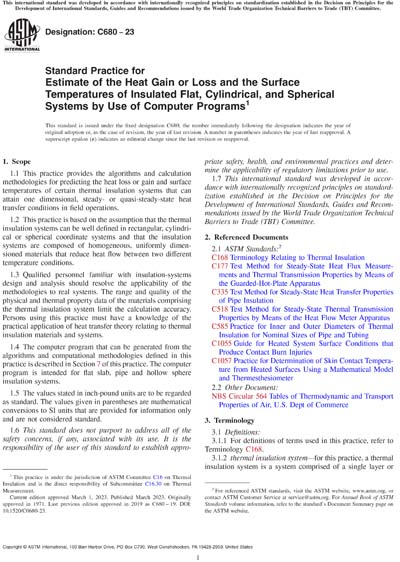Historical
ASTM C680-23
Standard Practice for Estimate of the Heat Gain or Loss and the Surface Temperatures of Insulated Flat, Cylindrical, and Spherical Systems by Use of Computer Programs
1.1This practice provides the algorithms and calculation methodologies for predicting the heat loss or gain and surface temperatures of certain thermal insulation systems that can attain one dimensional, steady- or quasi-steady-state heat transfer conditions in field operations.
1.2This practice is based on the assumption that the thermal insulation systems can be well defined in rectangular, cylindrical or spherical coordinate systems and that the insulation systems are composed of homogeneous, uniformly dimensioned materials that reduce heat flow between two different temperature conditions.
1.3Qualified personnel familiar with insulation-systems design and analysis should resolve the applicability of the methodologies to real systems. The range and quality of the physical and thermal property data of the materials comprising the thermal insulation system limit the calculation accuracy. Persons using this practice must have a knowledge of the practical application of heat transfer theory relating to thermal insulation materials and systems.
1.4The computer program that can be generated from the algorithms and computational methodologies defined in this practice is described in Section 7 of this practice. The computer program is intended for flat slab, pipe and hollow sphere insulation systems.
1.5The values stated in inch-pound units are to be regarded as standard. The values given in parentheses are mathematical conversions to SI units that are provided for information only and are not considered standard.
1.6This standard does not purport to address all of the safety concerns, if any, associated with its use. It is the responsibility of the user of this standard to establish appropriate safety, health, and environmental practices and determine the applicability of regulatory limitations prior to use.
1.7This international standard was developed in accordance with internationally recognized principles on standardization established in the Decision on Principles for the Development of International Standards, Guides and Recommendations issued by the World Trade Organization Technical Barriers to Trade (TBT) Committee.
ASTM International [astm]

